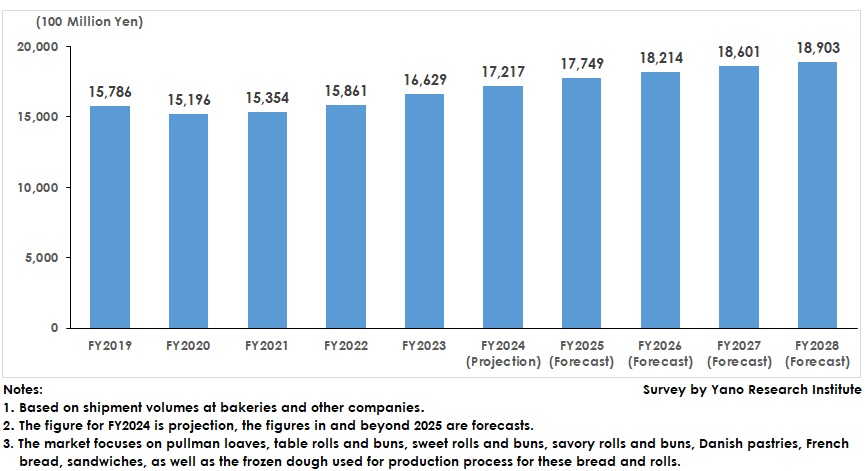No.3818
Bread and Rolls Market in Japan: Key Research Findings 2025
Domestic Bread and Rolls Market in FY2023 Outperformed the FY2019 Level, Entering Re-Growth Phase
Yano Research Institute (the President, Takashi Mizukoshi) surveyed the bread and rolls market in Japan and found out the market trends by product and retail channel, the trends of market players, and the future perspective.

Market Overview
This research calculates the size of the bread and rolls market with the focus on seven types: Pullman/English loaf, table roll, sweet bun and roll, savory bun and roll, Danish pastry, French bread, and sandwiches. The market size reached 1,662.9 billion yen in FY2023, marking a 4.8% increase from the previous fiscal year.
The bread and roll market is on the road of recovery from the plunge caused by the pandemic, experiencing a resurgence in demand.
Increased outing opportunities have fueled demand for affordable sweet and savory buns and rolls that can be eaten anytime, anywhere. As commodity prices continue to rise, cost-effectiveness is valued by price-conscious consumers, making packaged buns and rolls more popular.
Conversely, the Pullman bread market, which temporarily boomed during the pandemic, as a part of consumers’ efforts to make their time at home more enjoyable, has slowed down since the pandemic ended.
By channel, demand for bread and rolls from establishments of food service chains is reviving due to the normalization of social activities and the recovery of foot traffic. The return of inbound demand, including a growing number of foreign travelers and their substantial spending on tourism, has led to steadfast demand at hotels. These phenomena indicate structural changes in bread and roll consumption following the pandemic. The future growth of the bread and roll market seems to depend on the ability to respond to consumer needs, with price orientation and convenience being pivotal factors.
Noteworthy Topics
Rising Onigiri Prices and Rice Shortages Caused Savory Rolls to Gain Attention
Savory buns and rolls are characterized by a wide variety of appetizing shapes and sizes, including curry filled fried buns, yakisoba-filled rolls, and tuna-mayo buns, to name a few. Competition in the market is fierce, and individually packaged ones are available at room temperature.
Bakeries offer a wide variety of freshly baked, small-batch original products, which can differentiate themselves from major companies that use machines for most of the production processes to mass-produce bread and rolls. Bakeries excel at providing original, freshly made fillings.
In 2024, rice shortages and soaring prices led to a continuous increase in the price of onigiri, or rice balls, at convenience stores and mass merchandisers. Since then, bakeries and wholesalers have focused on savory rolls and buns, aiming to obtain substitute demand.
Future Outlook
The bread and roll market in Japan is expected to experience continued low growth due to an aging population and declining birth rates. There are concerns about shortages in wheat and oil supplies due to increased demand in emerging countries and to abnormal weather worldwide, both of which could lead to soaring prices.
However, multiple growth factors may boost the market, such as the launch of high-quality products with high unit prices, trending products that sell well, and growing demand for dinner loaves and rolls, including French bread.
Taking these factors into account, the market is projected to grow moderately. The market size is forecast to reach 1,890.3 billion yen by FY2028, which is a 13.7% increase from FY2023.
Research Outline
2.Research Object: Bakeries, retailers, and major companies that mass produce bread, rolls, sandwiches, and other baked products
3.Research Methogology: Face-to-face interviews (including online) by expert researchers, survey via telephone, mailed questionnaire, and literature research
What is the Bread and Rolls Market?
In this research, the bread and rolls market focuses on seven types of bread and rolls that are sold through following channels, as well as the frozen bread doughs used in their production. The market size was calculated based on the total shipment value of these products from bakeries, with the frozen dough included within.
- Bakeries: Retail bakery and retail chain stores that bake and sell bread and rolls in-store. This includes in-store bakeries at supermarkets and department stores.
- Convenience stores
- Mass Merchandisers: Stores that sell bread and rolls supplied from external bakeries. General supermarkets, food-only supermarkets, and co-op stores are included.
- Independent retailers: Retailers that are owned by one or more people and sell goods made by other companies. For baked goods, these retailers source from major wholesale bakeries.
- School Cafeterias: Bread and rolls delivered to school cafeterias.
- Others: Other channels include food service providers, such as bakeries with cafes, restaurants and hotels, diners, office cafeterias, and online stores.
<Products and Services in the Market>
1) Pullman/English loaves (regular & small sizes), including white bread, raisin bread, walnut bread, wheat germ bread, etc. 2) Table rolls: butter roll bun, parker-house roll, raisin roll, wheat germ roll, hamburger bun, etc. 3) Sweet buns & rolls (buns or rolls with sweet fillings): Sweetened bean curd (anko) roll (bun), cream roll, melon-pan (sweet bun covered with cookie dough), peanut-cream-filled roll, etc. 4) Savory rolls: Curry-filled donuts, sausage bun, roll with corn and mayo filling on top, etc. 5) Danish pastries: Croissant, pains au chocolat, applie pie, etc. 6) French bread: Baguette, thickened baguette, bour, pain d'epi 7) Sandwiches (fillings between slices of large loaves or between halved rolls): Packed triangular sandwiches, sandwiches in a box, Yakisoba roll, hamburger, etc. *Frozen bread dough includes dough for business use, such as at food service establishments, such as bakeries and hotels. These can be frozen dough balls, frozen molded dough, frozen fermented dough, and frozen semi-baked dough.
Published Report
Contact Us
The copyright and all other rights pertaining to this report belong to Yano Research Institute.
Please contact our PR team when quoting the report contents for the purpose other than media coverage.
Depending on the purpose of using our report, we may ask you to present your sentences for confirmation beforehand.